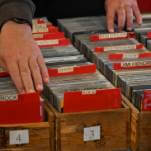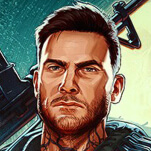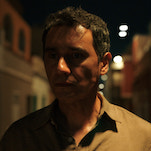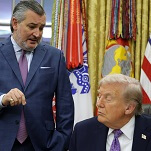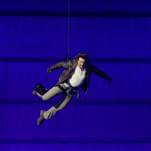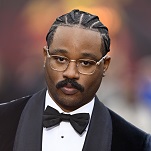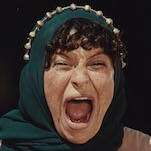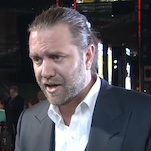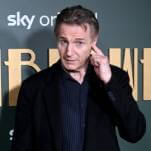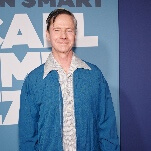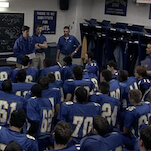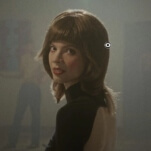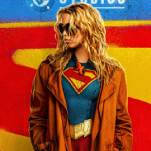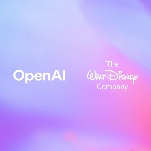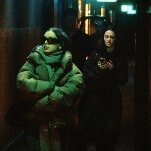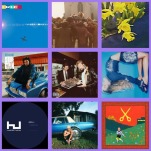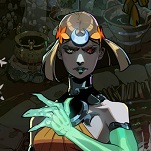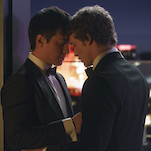With Podcast Canon, Benjamin Cannon analyzes the history of podcasts and interrogates how we talk about the art form.
Is there another show whose moment of relevance has come quite so suddenly and unexpectedly as that of the Beef And Dairy Network podcast? Welsh comedian Benjamin Partridge, the show’s creator and host, could hardly have predicted it when he started the show a decade ago, but his deliciously postmodern program chronicling the comic absurdities of a monomaniacally beef-obsessed alternate reality looks pretty close to our current one these days.
Our present paradigm is somehow more ridiculous than that of the show, with social media awash in everything beef and dairy—whether it’s eating raw offal, quaffing raw milk, or the baffling ascendancy of tallow as a sort of panacea—being peddled by influencers and grifters alike, including the actual United States Secretary for Health and Human Services at a Steak ‘n Shake (by Biglari—Doughboys fans are loving this parenthetical).
However crazy the world has gone for all things bovine at the moment, it still has nothing on the power of this podcast. Beef And Dairy sparkles thanks to its hilariously intelligent pursuit of utter comedic stupidity. But there’s something more at play here which elevates the show beyond merely being a dumb-funny trifle into something singularly imaginative, at times truly transcendent, and overall entirely deserving of a spot in the Podcast Canon. It’s the quality I find most absent from a lot of comedy podcasts, if I’m being honest: panache.
This sense of outlandish daring runs throughout the show, which isn’t content to simply have fun improvising deadpan discussions and calling it a day. Instead, Partridge, along with a rotating band of collaborators, takes what could be a very simple premise and endeavors to push it in every new direction possible. Within the world of the show, the podcast is merely an audio extension of a storied British periodical for those involved, or just interested, in the production of beef animals and dairy herds. With this narrative frame, the podcast plays more like a terrestrial radio program, with A and B stories, interstitials, and listener feedback. All of this is aided by excellent production and sound design, nailing the tone and cadence of traditional broadcasts so well it could easily pass for nonfiction, were it not for the utterly batshit beef-centric stories being told.
That foundation provides a great place from which to build, and Partridge has been locked in its demented construction ever since, like an audio Antoni Gaudí willing this taurine Sagrada Familia into cursed existence. For instance, we learn that there are canonically only four meats—beef, chicken, pork, and lamb—of which the ovine meat is seen as a dangerous drug to be avoided at all costs. There is no such thing as a “fifth meat,” no matter what else it is you think you’ve heard. Also, in the world of the show, beef isn’t merely everyone’s favorite food, it is a set of wings; it is a basket into which we pour our hopes and dreams.
Beef And Dairy‘s combination of inherent surreality and lived-in world is deftly aided by the richness and sincerity of its performances, which help to ground the comedy in a kind of reality, however bizarre it may be. This is due in large part to the intense commitment from Patridge, as the unnamed host, and his cavalcade of guests, who play their conversations entirely straight, no matter how eye-wateringly funny they may be. The absence of laughter or any winking comment only helps to heighten the comedy. It doesn’t hurt that the writing and improvisation are tack-sharp, and often aimed as much at fleshing out the show’s narrative and endowing it with a sense of history as they are to the comedy of it.
On the topic of the show’s longevity, I’d say any podcast lasting a decade is an impressive feat on its own, but one with such a narrowly specific remit as Beef And Dairy is something else entirely. I believe that it is largely attributable to the support it receives as a part of podcast pioneer Jesse Thorn’s Maximum Fun network of programs. At a time when most of the major podcast networks have shrunk considerably or disappeared altogether, the worker-owned cooperative and membership model approach Max Fun employs has proved to be impressively robust. As I write this, the network is just wrapping up its annual fund drive, and hearing about it on all of their shows warms my bleeding little liberal heart every time.
As a member of the network, Beef And Dairy has been afforded the freedom to chart its own course without sacrificing its core tenets in the name of increased advertising revenue or a pivot to video. Somewhat astonishingly, the show has only ever run a single midroll ad each episode since joining the network, and always for the same client—the hiring service ZipRecruiter. This is usually not a noteworthy detail, but Partridge’s inventiveness ended up making the host-read ads an indelible part of the show’s landscape. As a result of his repeating the custom URL at the end of each ad—ziprecruiter.com/beef—Partridge backed his way into creating the character Slash Beef, a vigilante in a dystopian world where beef has been banned. Where other podcast ads are destined to end up being skipped, the escapades of Slash Beef developed into a micro-show of their own with ongoing storylines and characters. It speaks to the importance of static, host-read advertisements in podcasting that these became such a part of the show and, as such, are still available for listeners instead of being replaced dynamically for the sake of mining the archives.
Perhaps it’s not entirely honest to say the show only has one advertiser, however. Often episodes feature a message from presenting sponsor Mitchell’s Farm Supplies, the multinational conglomerate peddling increasingly convoluted and ethically dubious remedies for beleaguered cattlemen. The Mitchell’s ads come courtesy of the actress Linnea Sage, whose spunky voice has graced almost every episode from debut to present. It’s an admittedly throwaway gag to open the show, but somehow over a decade of listening, it has become a cherished part of the program. This consistency pays dividends with each successive monthly release, as products evolve and new ones are introduced along the way, and often end up being incorporated into the world of the show. Sage’s nameless pitchwoman eventually becomes a character later on in the podcast’s run, capitalizing on a decade of her constant presence by flipping the script on her cheerful persona.
It’s worth taking a moment to recognize the other supporting players, too, for they are consistently the comedic engine, with Partridge opting for the more anodyne role as host. Mike Wozniak and Henry Paker are the show’s most frequent guests—as bovine arse vet Bob Trescothick (sexually, he goes like a train) and bovine poet laureate Michael Banyan (who has a cow’s face stitched onto his own), respectively—along with scads of other one or two-off characters along the way. The trio’s synchronicity even led them to spin off the experimental, freeform chat podcast Three Bean Salad in the pandemic.
Fellow Welshman Mike Bubbins created what is easily the show’s signature character, disgraced slaughterhouse operator Eli Roberts, whose wild trajectory encompasses everything from operating a mosquito zoo to leading a cult and cultivating an army of chimpanzees to act as security for his precious meat. Bubbins is a rare find; his gruff Welsh accent and impressively clever improvisation make every rage-filled Roberts appearance a wild treat. Ed Gamble—of the immensely popular Off Menu podcast with James Acaster—is a downtrodden delight playing Phillip Seastram, the milquetoast foil for Roberts and perpetually unsuspecting magnet for his bellicosity.
The rest of the roster of regular supporting performers are no less talented, and very much deserve to be named here. They have included Nadia Kamil, Tom Neenan, Tom Crowley, Mike Shephard, Gemma Arrowsmith, Tim Bick, Lucy Farrett, and Rhodri Viney. I feel like a special mention also needs to be made here for the panoply of insane character names that have come up over the course of Beef And Dairy‘s 120 episodes. It’s a list so colorful it would surely make Thomas Pynchon go green, whether from jealousy or nausea I can’t rightly say. Here are just a choice few: John Wasabi, Parsnip Flendercroft, Basil Kitesworthy, Talbot Baritone, Runyon Cradge, Lesley Sunrider, Melanie Handcatch, and Chup Bupkins (or was it Bup Chupkins?).
In addition to the regular cast, Beef And Dairy has attracted many of American comedy’s brightest lights to play in its unhinged sandbox as well, whether it’s Andy Daly, Nick Offerman, Paul F. Tompkins, or Jason Mantzoukas. However, the most impressive get came last April when the show capped an obscure, years-long running joke about the network’s massive grain debt owed to the actor Ted Danson by having an especially game Danson appear in an episode as his in-universe self and terrorize Partridge throughout.
The Danson episode is perhaps the show’s crowning achievement, but only as it was the culmination of several episodes of groundwork, stemming from that same ingrained sense of panache and the show’s playful stretching of the form. Originating as a tossed-off joke in “Episode 64: Goodbye Bimpsie,” it reached its apex with the Blue Jam-inflected Episode 84: The Lord Of The Sun,” before the ultimate denouement of “Episode 109: Ted Danson.” That kind of run for a semi-improvised beef-based news magazine program is simply unheard of. In addition, episodes like “Episode 40: Beef Call,” which I find to be a good standalone taste of what the show is like, “Episode 23: 75th Anniversary Special,” and “Episode 77: Marianne Angler,” stand out as combined achievements in writing, editing, and sound design far beyond most other comedy podcasts.
In short, Beef And Dairy Network is a special show—certainly one of the most singular comedy creations of its time, but also one whose overly specific logline has perhaps made it easy for audiences to overlook. It stands as a true testament to a sort of nostalgic approach in podcasting. Both in creating audio for the pure love of the craft, and also in finding a sense of belonging on a podcast network that champions the medium for all the reasons that make it great. If that doesn’t sound like something worthy of entry into the Podcast Canon, get back in the truck.


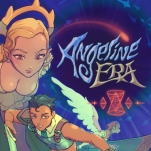
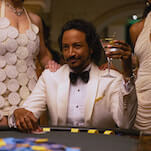
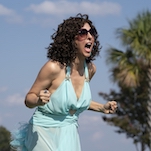
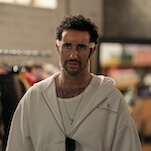
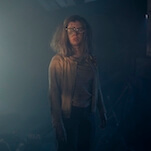

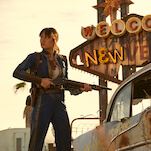
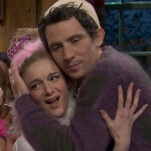
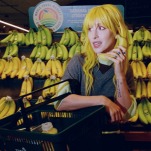



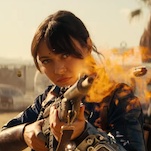
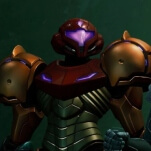
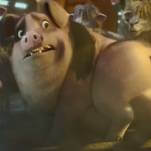

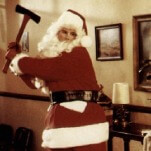
![HBO teases new Euphoria, Larry David, and much more in 2026 sizzle reel [Updated]](https://img.pastemagazine.com/wp-content/avuploads/2025/12/12100344/MixCollage-12-Dec-2025-09-56-AM-9137.jpg)
